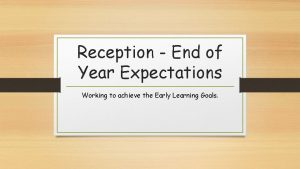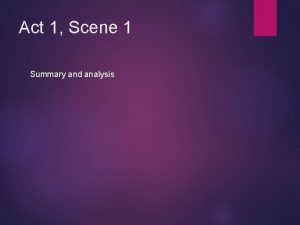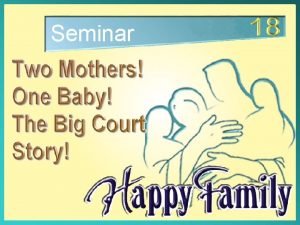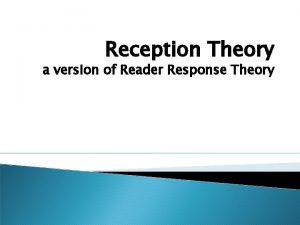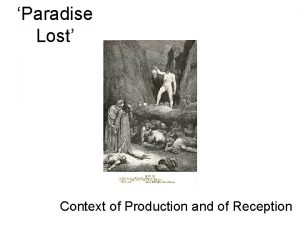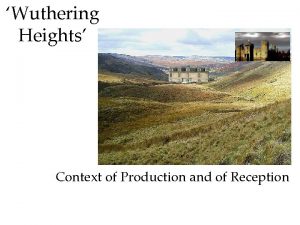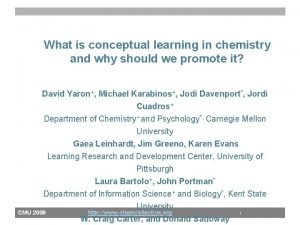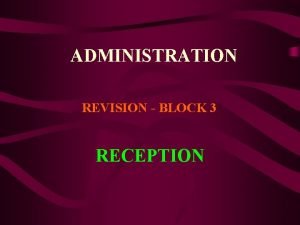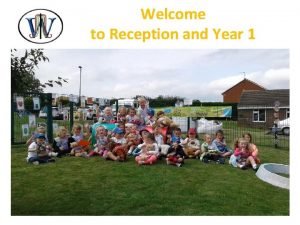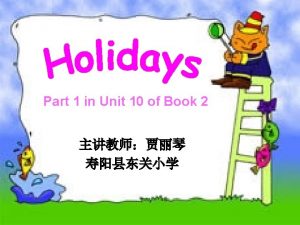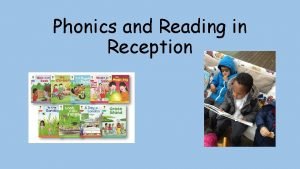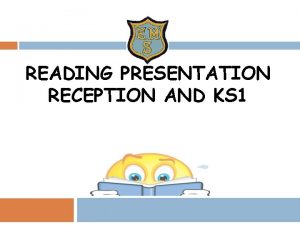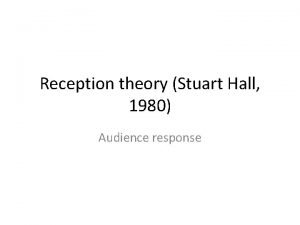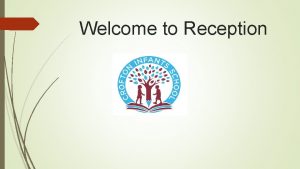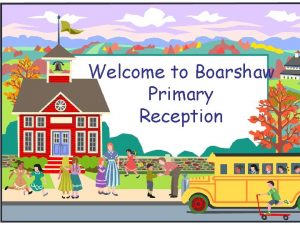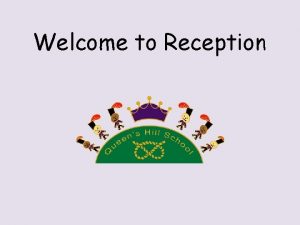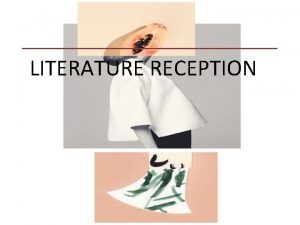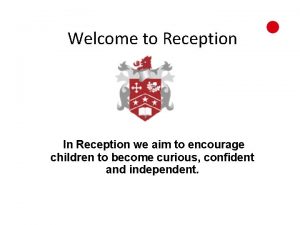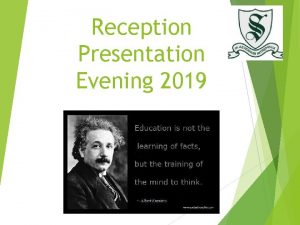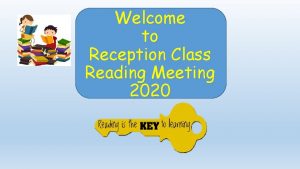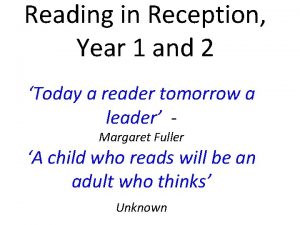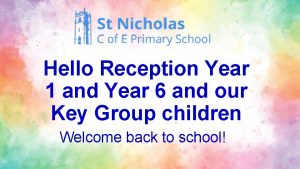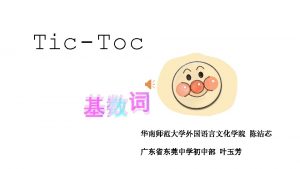Reading in Reception Year One and Year Two






























- Slides: 30

Reading in Reception, Year One and Year Two Sarah Walton, Emma Fitzpatrick and Avalon Mountford

Key Experiences in Reading

Key Experiences in Reading • Adult reading aloud to children daily • Shared reading with enlarged texts • Adult writing children’s ideas • Storytelling • Adults talking about reading with enthusiasm

Key Experiences in Reading • • • Reading in groups/pairs Listening to songs, rhymes and poems Reading individually to an adult Opportunities to browse and choose own books Discussing books Using story props and playing reading games Role play and drama based around texts Book-making Reading and re-reading quality texts Building up a repertoire of favourite books

Key Experiences in Reading • Research using information texts • Using a wide range of strategies when reading • • Phonics Contextual clues Grammatical clues Visual clues • Home-School reading partnerships • Careful tracking and assessment to support progress

Key Texts

Key Texts • Each year group teaches literacy through a key text linked to the topic. All classroom literacy is based on a key text. • The key texts provide a basis for the learning opportunities on the previous slides.

Different Methods of Teaching Reading

Individual Reading • Has a duration of about 5 minutes per child per week • 1: 1 teacher and child • Focuses on individual children’s needs • Supports children’s confidence • Takes place when most children are having lunch, only a few children in the classroom at the time

Guided Reading • Children read in small groups of 6 children • Read with the teacher once a week • Session lasts for about 20 minutes • Teaching is based around general needs for the children in that group • In the 20 minutes… • • Teachers teach a concept Children read as a group/individually/out loud/take turns etc Teacher makes notes on each child Teacher writes title of book in reading diary

Shared Reading • Children read in a whole class group • Teacher reads with group five times a week • Each session lasts for 20 minutes • Teaching is based on the general needs for the children in the class BUT teachers plan for different groups of children through questions • In the 20 minutes… • • • Review phonemes that will occur in the book Review common exception words that will occur in the book Read some of the text in unison Read some of the text individually with the teacher listening to them read Answer comprehension questions either written or oral • Teacher is able to plan any changes for the lesson the following day

Different Types of Books

Reading Scheme Books Are written with the sole purpose of teaching reading They are used as a gateway to reading – the means to an end MUST run alongside real books Chosen to match a child’s reading ability Often link directly to phonics teaching Often have prompts for adults reading with the child Are sometimes written by notable authors eg Julia Donaldson Are used for individual reading in Reception and shared reading in Year One • Are available online through the Bug Club resources to read at home. • •

Bug Club – Active Learn Primary



www. oxfordowl. co. uk



Real Books • Are written with the purpose of entertaining the reader • The aim of becoming a reader • Are appealing to different levels of reader • Contain the features of key texts for teaching reading • Encourage favourites • Are chosen by children for the illustrations or themes • Are chosen by the children to read for enjoyment

Current Teaching in our Year Groups

The Current Position in Reception • Children do shared reading every day using the Bug Club Books online • Children learn phonics every day in a discrete session • Children read individually with the teacher once a week for about five minutes. • Children read throughout the day as part of ongoing continuous activities eg in the book corner, in the role play area, on the story telling chair, in the small world etc. • Children bring home one scheme book plus one real book • Bug Club books will soon be allocated electronically

The Current Position in Years One and Two • Children do shared reading every day using the Bug Club Books online • Children learn phonics every day as part of the reading session • Children read individually within the shared reading session • Children read throughout the day as part of ongoing continuous activities eg in the book corner, in the role play area, on the story telling chair, in the small world etc. • Children bring home one scheme book (online) and two real books

Reasons for Changes in Key Stage One • Since October we have been doing BOTH shared reading and guided reading • In a recent phase meeting where all ten teachers were present, we agreed that, in our experience, the most progress had been seen as a result of shared reading • 20 minutes per group once a week is not generating us as much progress as 20 minutes per class per day • Guided Reading books have not always been read at home and are not returned, we have many incomplete sets of books • Reading diaries have often not been commented in • Research shows that shared reading is the most effective method of teaching reading in class

Shared reading can: Improve children’s motivation to read Improve their vocabulary Improve the likelihood of a child choosing to read independently Improve writing ability Expose children to a wider variety of texts Enhance children’s understanding of a text Enhance children’s socio-emotional development

Before (per week) Now (per week) 5 minutes reading time with the teacher per child I hour and 40 minutes reading time with the teacher as a class (every child has the opportunity to read out loud answer questions on the text) Bringing home 2 books a week and assigned an online book to read

Reading at Home

Reading at Home - For Learning • The book from the teacher is a form of homework and should be read at an appropriate time for learning • Children should be expected to concentrate and actively engage in reading the book • Children should be encouraged to read the text that they have been given. • They should be encouraged to sound out words that the do not know • Adults may ask questions about the text, maybe from the back of the book itself, or from the list of questions provided

Reading at Home – For Pleasure • Children should have the opportunity to share a book with a family member every night before they go to bed. • This time should be enjoyable and relaxing before bedtime and should form part of a bedtime routine. • The books should be chosen for enjoyment. • Books could be chosen from home collections, the local library or the school library. • Family members should share the book with the child by reading to them, or reading together. • There should be no expectation of the child to do reading homework at bedtime. www. schoolreadinglist. co. uk (recommended books for year groups)

Any Questions…
 Structure of twelfth night
Structure of twelfth night While reading activities
While reading activities Reception end of year expectations
Reception end of year expectations Act 1 scene 1 hamlet
Act 1 scene 1 hamlet One god one empire one religion
One god one empire one religion One one one little puppy run
One one one little puppy run One king one law one faith
One king one law one faith Byzantine definition
Byzantine definition One ford plan
One ford plan See one do one teach one
See one do one teach one One price policy
One price policy Studiendekanat uni bonn
Studiendekanat uni bonn One vision one identity one community
One vision one identity one community Asean one vision one identity one community
Asean one vision one identity one community One baby and two mothers story
One baby and two mothers story Reception theory examples
Reception theory examples Letters and sounds reception
Letters and sounds reception Paradise lost context
Paradise lost context Pgp message generation and reception
Pgp message generation and reception Privacy enhanced mail
Privacy enhanced mail Context of production and reception
Context of production and reception Context of production and reception
Context of production and reception Aims of teaching
Aims of teaching What are types of reading
What are types of reading Real definition of extensive reading
Real definition of extensive reading Intensive reading and extensive reading
Intensive reading and extensive reading Style of reading
Style of reading Cern reception building 33
Cern reception building 33 Mixed reception virtual lab answers
Mixed reception virtual lab answers Cern goods reception
Cern goods reception Chemcollectivevirtuallab
Chemcollectivevirtuallab


